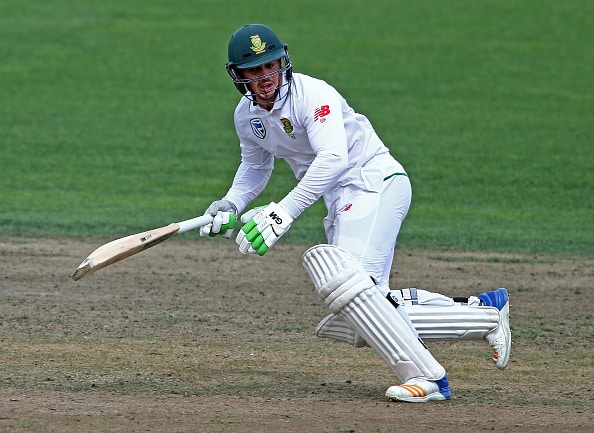Quinton de Kock showed why he should not be moved up the Proteas’ batting order, writes GARY LEMKE.
It was former South African batsman Daryll Cullinan who last week courted controversy when he suggested that De Kock should be promoted to No 4 in the batting, while JP Duminy was no longer deserving of his place in the starting XI.
Of course, social media ‘conversation’ lit up, some agreeing with him and some telling him to sit back down. After watching De Kock stroke 90 off 118 balls to help steer the Proteas from 148-5 to 295-9, when he was eventually trapped lbw by Neil Wagner, Cullinan might have more agreeing with him than not.
De Kock now has nine Test fifties to go with his three hundreds, and his 90 on the second day of the final Test against New Zealand in Hamilton nudged his average over 50, to 50.69.
Obvious comparisons are already being made with the Australian Adam Gilchrist, whose 96 Tests for Australia saw him average 47.60, while hitting 17 hundreds in the process. His career strike rate was 81.95, a phenomenal statistic when one considers that De Kock’s Test strike rate is 72.29.
Gilchrist used to come in at No 7 in the order and dominate the bowling like we hadn’t seen from a wicketkeeper-batsman before. Generally speaking, you’re into the tail when the seventh wicket of an innings has fallen, but Gilchrist used to take the fight to the opposition and often, when the bowlers looked up at the scoreboard again, between 100 and 150 runs had been added before the last wicket fell.
De Kock is cut from the same cloth. A natural ball-striker, he’s also left-handed and plays his shots. He arrived at the crease in Hamilton after Temba Bavuma had, again, fallen prey to the hook shot for 29, and when his captain Faf du Plessis fell to a stunning catch for 53, the Proteas were again against the ropes, with six wickets down for 190.
However, the 24-year-old took the game, and the series, away from New Zealand with another exhibition of fearless strokeplay, being especially strong square both sides of the wicket.
With some rain forecast over the remaining three days, and New Zealand closing on 67-0 to be 247 runs still in arrears, this match d appears to have draw written all over it, which could see South Africa return home with a 1-0 series win in the bag.
Keshav Maharaj, however, did get some noticeable bounce and turn late in the final session to suggest that he could make things uncomfortable for the New Zealanders on a third day that will be the defining day of this particular Test.
However, the Proteas wouldn’t be in the position that they are in, had it not been for another successive score in the 90s from De Kock.
Promoting him in the order, as suggested by Cullinan and supported by others, would be the wrong thing to do. There might be a strong argument to suggest he could be pushed up to No 6, but that would mean replacing Bavuma and that’s not going to happen in the forseeable future, so De Kock is stuck at No 7.
And that’s not a bad thing. Imagine how potent this Proteas batting line-up will be once the top-order starts firing again and not having to rely on the lower-order heroics, where 95 runs were added in the last three wickets after Vernon Philander fell with the score on 219.
REPORT: De Kock piles pressure on Kiwis
De Kock is also capable against the second new ball, and that’s what you want in a No 7 batsman. No opposing team will enjoy running their finger down the South African batting line up and see De Kock’s name inked in at No 7. They would probably want him higher up as well, to have a better chance of knocking him over early in the day, and then running through the rest of the order.
So, no thanks. I’m happy to see him where he is, instilling fear into the opposition dressing room and going about the work he does, which is to quickly change the course of an innings, or indeed the match, in a very short space of time.
Photo: Dave Rowland/Getty Images





